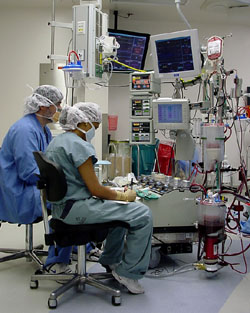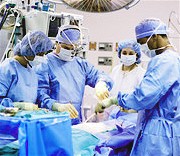Thousands of heart surgeries are performed every day in the United States. In fact, in a recent year, surgeons performed 500,000 coronary bypass procedures. And even though there is a shortage of donor organs, more than 2,300 people have heart transplants each year.
Two major advances in medicine made heart surgery possible:
- The heart-lung machine, which takes over the work of the heart.
- Body cooling techniques, which allow more time for surgery without causing brain damage.
What is a heart-lung machine?
|

|
|
Perfusion technologists operate the heart-lung machine during surgery. | |
The heart-lung machine is also called a cardiopulmonary bypass machine. It takes over for the heart by replacing the heart's pumping action and by adding oxygen to the blood. This means that the heart will be still for the operation, which is necessary when the heart has to be opened (open heart surgery).
When you are connected to the heart-lung machine, it does the same job that your heart and lungs would do. The heart-lung machine carries blood from the upper-right chamber of the heart (the right atrium) to a special reservoir called an oxygenator. Inside the oxygenator, oxygen bubbles up through the blood and enters the red blood cells. This causes the blood to turn from dark (oxygen-poor) to bright red (oxygen-rich). Then, a filter removes the air bubbles from the oxygen-rich blood, and the blood travels through a plastic tube to the body's main blood conduit (the aorta). From the aorta, the blood moves throughout the rest of the body.
The heart-lung machine can take over the work of the heart and lungs for hours. Trained technicians called perfusion technologists (blood flow specialists, also called the "pump team") operate the heart-lung machine.
See also on this website: What is a Perfusionist?
What are cooling techniques?
Cooling techniques let surgeons stop the heart for long periods without damaging the heart tissue. Cool temperatures avoid damage to the heart tissue by reducing the heart's need for oxygen.
The heart may be cooled in 2 ways:
- Blood is cooled as it passes through the heart-lung machine. In turn, this cooled blood lowers body temperature when it reaches all of the body parts.
- Cold salt-water (saline) is poured over the heart.
After cooling, the heart slows and stops. Injecting a special potassium solution into the heart can speed up this process and stop the heart completely. The heart is then safe from tissue injury for 2 to 4 hours.
|
View of a coronary artery bypass operation from observation dome overhead. | |
Who is in the operating room during surgery?
During heart surgery, a highly trained group works as a team.
- The cardiovascular surgeon heads up the surgery team and performs the key parts of the surgery.
- The assisting surgeons follow the direction of the cardiovascular surgeon.
- The cardiovascular anesthesiologist gives you the medicines that make you sleep during the surgery (called anesthesia) and monitors the ventilator, which breathes for you during surgery.
- The perfusion technologists run the heart-lung machine.
- The cardiovascular nurses are specially trained to assist in heart surgery.
What kinds of heart and blood vessel surgeries are there?
Coronary Artery Bypass
This is the most common kind of heart surgery, also called coronary artery bypass graft surgery (CABG), coronary artery bypass (CAB), coronary bypass, or bypass surgery.
The surgery involves using a healthy section of blood vessel from another part of the body to bypass a part of a diseased or blocked coronary artery. This creates a new route for blood to flow, so that the heart muscle will get the oxygen-rich blood it needs to work properly.
During bypass surgery, the breastbone (sternum) is divided, the heart is stopped, and blood is sent through a heart-lung machine. Unlike other kinds of heart surgery, the chambers of the heart are not opened during bypass surgery.
The terms single bypass, double bypass, triple bypass, or quadruple bypass refer to the number of arteries that are bypassed.
See also on this site: Coronary Artery Bypass Surgery
Valve repair or replacement
Blood is pumped through your heart in only one direction. Heart valves play key roles in this one-way blood flow, opening and closing with each heartbeat. Pressure changes behind and in front of the valves allow them to open their flap-like "doors" (called cusps or leaflets) at just the right time, then close them tightly to prevent a backflow of blood.
Two of the most common kinds of valve problems that require surgery are
- Stenosis, which means the leaflets do not open wide enough and only a small amount of blood can flow through the valve. Stenosis (narrowing) occurs when the leaflets thicken, stiffen, or fuse together. Surgery is needed to either open the valve that is there or replace it with a new one.
- Regurgitation, which is also called insufficiency or incompetence, means that the valve does not close properly and blood leaks backward instead of moving in the proper forward direction. Surgery is needed to either tighten or replace the valve.
Surgical repair of a valve involves the surgeon rebuilding the valve so that it will work properly. Valve replacement means that the valve is replaced with a biological valve (made of animal or human tissue) or a mechanical valve (made from materials such as plastic, carbon, or metal).
See also on this site: Valve Repair or Replacement Surgery
Arrhythmia Surgery
Any irregularity in your heart's natural rhythm is called an arrhythmia. Arrhythmias are usually treated first with medicines. Other treatments may include
- Electrical cardioversion, where the cardiologist or surgeon uses paddles to "shock" the heart back into a normal rhythm.
- Catheter ablation, where the cardiologist uses a special tool to destroy (ablate) the cells that are causing the arrhythmia. This is done in the cardiac catheterization laboratory (the cath lab).
- Pacing and rhythm-control devices, including pacemakers and implantable cardioverter defibrillators (ICDs). Patients can have these devices implanted while in the operating room or the cath lab.
When these treatments do not work, surgery may be needed. One type of surgery is called Maze surgery. In Maze surgery, surgeons create a "maze" of new electrical pathways to let electrical impulses travel easily through the heart. Maze surgery is used most often to treat a type of arrhythmia called atrial fibrillation. Atrial fibrillation is the most common type of arrhythmia.
Aneurysm Repair
An aneurysm is a balloon-like bulge in a blood vessel or in the wall of the heart. An aneurysm occurs when the wall of a blood vessel or the heart becomes weakened. Pressure from the blood forces it to bulge outward, forming what you might think of as a blister. An aneurysm can often be repaired before it bursts.
Surgery involves replacing the weakened section of blood vessel or heart with a patch or artificial tube (called a graft).
Aneurysms in the wall of the heart occur most often in the lower-left chamber (called the left ventricle). These aneurysms are called left ventricular aneurysms, and they may develop after a heart attack. (A heart attack can weaken the wall of the left ventricle.) If a left ventricular aneurysm leads to an irregular heartbeat or to heart failure, the surgeon may perform open heart surgery to remove the damaged part of the wall.
See also on this site: Aneurysm Repair
Transmyocardial Laser Revascularization (TMLR)
Angina is the pain you feel when a diseased vessel in your heart (called a coronary artery) can no longer deliver enough blood to a part of the heart to meet its need for oxygen. The heart's lack of oxygen-rich blood is called ischemia. Angina usually occurs when your heart has an extra need for oxygen-rich blood, such as during exercise. Angina is nearly always caused by coronary artery disease (CAD).
Transmyocardial laser revascularization (TMLR) is a procedure that uses lasers to make channels in the heart muscle, in an attempt to allow blood to flow from a heart chamber directly into the heart muscle. If the blood flow is increased, more oxygen can reach the heart. This procedure is only done as a last resort. For example, TMLR may be done in patients who have had many coronary artery bypass operations and cannot have another bypass operation.
See also on this site: Transmyocardial Laser Revascularization (TMLR)
Carotid Endarterectomy
Carotid artery disease affects the vessels leading to the head and brain. Like the heart, the brain's cells need a constant supply of oxygen-rich blood. This blood supply is delivered to the brain by the 2 large carotid arteries in the front of your neck and by 2 smaller vertebral arteries at the back of your neck. The right and left vertebral arteries come together at the base of the brain to form what is called the basilar artery. A stroke most often occurs when fatty plaque blocks the carotid arteries and the brain does not get enough oxygen.
Carotid endarterectomy is the most common surgical treatment for carotid artery disease. Surgeons make an incision at the location of the blockage in the neck and a tube is inserted above and below the blockage to reroute blood flow. Surgeons can then remove the fatty plaque.
A carotid endarterectomy can also be done by a technique that does not require blood flow to be rerouted. In this procedure, the surgeon stops the blood flow just long enough to peel the blockage away from the artery.
See also on this site: Carotid Endarterectomy
Heart Transplantation
The first heart transplants were performed in the late 1960s. But it was not until the use of anti-rejection medicines in the 1980s that the procedure became an accepted operation. Today, heart transplantation gives hope to a select group of patients who would otherwise die of heart failure.
The need for a heart transplant can be traced to one of many heart problems, each of which causes damage to the heart muscle. The two most common heart problems are idiopathic cardiomyopathy (disease of the heart muscle without a known cause) and coronary artery disease (the buildup of plaque in the arteries of the heart).
As the heart problem gets worse, the heart grows weaker and is less able to pump oxygen-rich blood to the rest of the body. Because the heart must work harder to pump blood through the body, it tries to make up for this extra work by becoming enlarged (hypertrophied). In time, the heart works so hard to pump blood that it may simply wear out, overcome by disease and unable to meet even the smallest pumping demands. Medicines, mechanical devices to assist the heart, and other therapies (including stem cell therapy) can sometimes help and even improve a patient's condition. But when those treatments fail, transplantation becomes the only option.
See also on this site:



